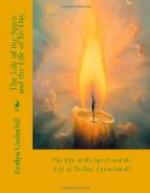Such a view brings them more near to us, helps us to neglect mere differences of language and appearance, and grasp the warmly living and contemporary character of all historic truth. It preserves us, too, from the common error of discriminating between so-called “ages of faith” and our own. The more we study the past, the more clearly we recognize that there are no “ages of faith.” Such labels merely represent the arbitrary cuts which we make in the time-stream, the arbitrary colours which we give to it. The spiritual man or woman is always fundamentally the same kind of man or woman; always reaching out with the same faith and love towards the heart of the same universe, though telling that faith and love in various tongues. He is far less the child of his time, than the transformer of it. His this-world business is to bring in novelty, new reality, fresh life. Yet, coming to fulfil not to destroy, he uses for this purpose the traditions, creeds, even the institutions of his day. But when he has done with them, they do not look the same as they did before. Christ himself has been well called a Constructive Revolutionary,[47] yet each single element of His teaching can be found in Jewish tradition; and the noblest of His followers have the same character. Thus St. Francis of Assisi only sought consistently to apply the teaching of the New Testament, and St. Teresa that of the Carmelite Rule. Every element of Wesleyanism is to be found in primitive Christianity; and Wesleyanism is itself the tradition from which the new vigour of the Salvation Army sprang. The great regenerators of history are always in fundamental opposition to the common life of their day, for they demand by their very existence a return to first principles, a revolution in the ways of thinking and of acting common among men, a heroic consistency and single-mindedness: but they can use for their own fresh constructions and contacts with Eternal Life the material which this life offers to them. The experiments of St. Benedict, St. Francis, Fox or Wesley, were not therefore the natural products of ages of faith. They each represented the revolt of a heroic soul against surrounding apathy and decadence; an invasion of novelty; a sharp break with society, a new use of antique tradition depending on new contacts with the Spirit. Greatness is seldom in harmony with its own epoch, and spiritual




